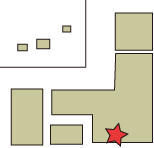Geku
|
 |
 |
Ise-jingu is very spacious shrine, and it is split in to two places. There are called, Naiku, and Geku. Generally, visiting Geku first is a custom. Geku is also called as "Toyoukedaijingu".
This is the main sanctuary in Geku, and it is called "Goshouden".
This Toyoukedaijinngu is dedicated to the Toyoukueoomikami, the god of food, clothing shelter, and industry. Many people visit here, and pray to the god for there better luck in the future. |
|
Naiku
|
 |
|
Naiku is dedicated to Amateras-omikami, the goddess, and the ancestor of the Royal Family. There are more shrines in Naiku, than in the Geku. Naiku is also called as "Koutaijinngu" There is a river next to it called Isuzugawa River, and people cleanse themselves. |
|
Landscape
|
 |
 |
While walking to Goshougu, there is landscape like this. This is called Nihon-Teien, which means Japanese style garden. It is one of the traditional cultural assets, and each garden displays the natures, like mountain, river, and sea. This Ise jingu is surrounded by this green garden, so it looks like a big forest.
|
|
Goshouden
|
Goshouden is the main building in this Ise shrine. It is surrounded by very solid wooden fense. Goshouden is dedicated to the Amateras-omikami. Photographs prohibited in this place. |
|
Kaguraden
|
 |
|
This is a building called, Kaguraden. There are three same buildings, and the each building is called, Mikeden, Kaguraden, and Jyuyosho.
Mikeden: place where people purify by the priest, and get Ofuda(a piece of paper which protect yourself from the misfortune, devil and the bad souls), and rice cake offering.
Kaguraden: place where kagura is going on. Kagura is a event which sacred music and dancing perfomed by Miko(a maiden in the service of a shrine).
Jyuyosho: place where Omamori(lucky charm), Ofuda are selling, and also for getting donations from people for the ceremony.
|
|
|
Ise Jingu is the name of group of 125 shrines. It is also called as Oise-san. This shrine is the noblest shrine in Japan, because the god, Amateras-omikami is the ancestor of Japanese Imperial Household Family. Also all the Japanese are the "Ujiko" of the shrine, which means this shrine is the master shrine. All the buildings in this shrine are built by combining piece of woods, so they don't use nails at all. Also, all the buildings get reformed once in twenty years, which is the traditional ceremony in this shrine. The next ceremony will held on 2013. Today, many foreigners, and many generations visit this noble shrine. This shrine, tries to inherit 2000 years tradition to the younger generation.
|





